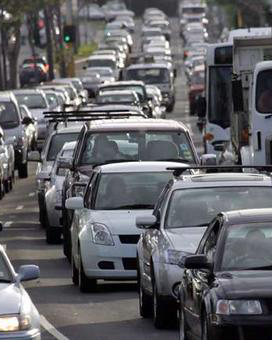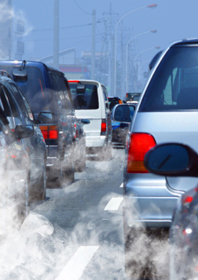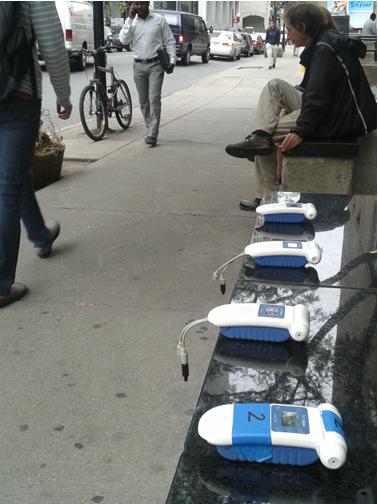| Projects | Publications |
 |
Simulating the environmental effects of isolated and network-wide traffic calming schemes using traffic simulation and microscopic emission modellingSponsors: Natural Sciences and Engineering Research Council (NSERC) Students: Golnaz Ghafghazi Various traffic calming measures with the means of improving road safety have been implemented all over the world for decades. Despite the beneficial effects of traffic calming, it has been associated with impacts on air quality. In fact, varying speed frequently and slowing down while driving on a calmed street, may tend to produce more air emissions due to increased accelerations and decelerations. While the safety impact of traffic calming has been studied, little research has been conducted to capture the environmental impacts of traffic calming measures. In this research project, we develop a microscopic traffic and emission simulation system which aims at quantifying the effects of different types of traffic calming measures on vehicle emissions in different boroughs within the Montréal Metropolitan Region. |
 |
Quantifying the effects of land-use and socio-economics on the generation of traffic emissions and individual exposure to air pollution at a metropolitan scaleSponsors: Collaborative Health Research Projects (CHRP) Students: Timothy Sider, Ahsan Alam, Mohamad Zukari, Nathan Goldstein, Hussam Dugum We are working on the development of a modelling framework for the metropolitan region of Montreal, Canada, that is intended to quantify two indicators that can explain the spatial distribution of traffic-related air pollution at a metropolitan level. The indicators include: (1) the average level of emissions generated per individual, and (2) the level of emissions occurring in a zone as a proxy for air pollution exposure. We observe that individuals who generate higher emissions from travel tend to reside in areas with lower exposure to traffic emissions while individuals associated with low levels of travel emissions (e.g. travel smaller distances, conduct less trips, use alternative modes) reside in areas with high levels of traffic pollution. |
 |
Evaluating the effects of vehicle fleet, travel demand, and road network changes on traffic emissions and near-road air quality in a dense urban neighbourhood using a microscopic simulationSponsors: City of Montreal & Natural Sciences and Engineering Research Council (NSERC) Students: Ahsan Alam, Golnaz Ghafghazi, Timothy Sider In this study we develop a traffic simulation for a dense neighbourhood in the City of Montreal (8,656 links) linked with a regional traffic assignment model used to determine the travel demand originating in- and destined to the study area. Using a version of the USEPA’s Motor Vehicle Emissions Simulator (MOVES) fit with local data, we simulate traffic emissions for each link using instantaneous speed profiles. Emissions of greenhouse gases (GHG), nitrogen oxides (NOx), and carbon monoxide (CO) are modelled under a range of regional and local policies including fleet renewal, street closures, reduced demand, reduced internal car trips, and reduced ‘through traffic’. |
 |
Measuring cyclists’ exposure to traffic emissions across urban cycling facilitiesSponsors: Collaborative Health Research Projects (CHRP) Students: William J. Farrell, Graeme Pickett, Martin Brownlie, Bernard Moulins, Julien Neves-Pelchat, Rhokho Kim, Mohamad Zukari, Nicolas Truong, Rebecca Luck This project seeks to examine the relationship between traffic emissions and cyclists’ exposure to air pollution across a variety of cycling facilities within the Island of Montreal. The concentrations of two pollutants, ultra-fine particulate matter (UFP) and black carbon (BC) were measured at each second along a set of cycling routes. Two pairs of research assistants cycled on 25 unique routes over a five-week period. Each route was measured on four occasions: during the morning and evening peak periods on two separate days. Each route was approximately 25 ± 3 km for a total of approximately 600 km, covering nearly all 425 km of cycling facilities on the Island of Montreal as well as other common cycling corridors. |
 |
A web-based route planning tool to reduce cyclists’ exposures to traffic pollution: A case study in Montreal, CanadaSponsors: Collaborative Health Research Projects (CHRP) Collaborator: Guillaume Barreau, PhD User-friendly tools that can be used to limit cyclists’ exposures to air pollution may have important public health benefits. As a case study, we developed a web-based route planning tool for Montreal, Canada, and evaluated whether this tool could lower air pollution exposures. This tool is based on spatial monitoring data for ambient nitrogen dioxide (a marker of traffic pollution; NO2) and provides users with the shortest route between an origin and a destination as well as a “lower exposure” alternative. With this tool, we estimated exposures to NO2 along shortest routes and lower exposure alternatives using origin-destination survey data collected in 2008. Low-exposure alternative routes were available for the majority of the 2,307 routes included in the analysis. On average, exposures decreased by 0.76 ppb (95% Confidence Interval: 0.72, 0.80) relative to the shortest route, with decreases of up to 6.1 ppb predicted for a single trip. The benefits of decreased exposure along alternative routes were often achieved with little increase (often less than 1 km) in the overall length of the route.
... Visit Our Clean Ride Mapper for Montreal |
 |
A microscopic simulation of transit bus emissions under transit signal priority and alternative technologySponsors: Natural Sciences and Engineering Research Council (NSERC) Students: Ahsan Alam We microsimulated the operations and emissions of transit buses along a busy transit corridor and quantified the effects of two different fuels (conventional diesel and compressed natural gas) as well as a set of driving conditions on emissions. Results indicate that compressed natural gas (CNG) reduces GHG emissions by 8-12% compared to conventional diesel. However, the benefits of switching from conventional diesel to CNG are less apparent when the road network is uncongested. As congestion levels rise, the emission reductions associated with CNG improve. We also investigated the effects of bus operations on emissions by applying several strategies such as transit signal priority (TSP), queue jumper lanes, and relocations of bus-stops. Results show that TSP alone can reduce emissions by 14% and when combined with improved technology; a reduction of 23% is achieved. The reduction benefits are even more apparent when other transit operational improvements are combined with TSP. |
 |
Investigating the isolated and combined effects of congestion, roadway grade, passenger loading, and alternative fuels on transit bus emissionsSponsors: Natural Sciences and Engineering Research Council (NSERC) Students: Ahsan Alam This study investigates the isolated
and combined effects of network congestion, roadway
grade, passenger load, and fuel type on transit bus
emissions of greenhouse gases (GHG) through a
simulation of transit operations and emissions along a
busy corridor. We also test the effect of changing
random seed on the overall corridor emissions. |
 |
Investigating the role of transport models in epidemiological studies of air pollution exposure and health effectsSponsors: Natural Sciences and Engineering Research Council (NSERC) Students: Maryam Shekarrizfard Urban air pollution has been linked with a range of health effects; in metropolitan areas on-road traffic is the largest contributor to local air pollution and therefore, exposure to traffic emissions could potentially explain the odds of air pollution related health effects among the general population. In this study, we investigate the possibility of using a transportation model developed for the City of Montreal for the purpose of deriving a measure of individual exposure to traffic emissions. |
 |
Testing portable electro-chemical air pollution sensors in order to capture the spatio-temporal variability of Nitrogen Dioxide in MontrealSponsors: Natural Sciences and Engineering Research Council (NSERC) Students: Laure Deville Cavellin, Ryan Tack This project aims at testing portable air pollution sensors in order to investigate their feasibility for spatio-temporal mapping of air pollution. We ran two data collection campaigns one in Summer 2014 and one in Fall 2014, with 6 to 12 measurements of NO2, temperature, relative humidity, and traffic at each of 77 locations. |